
This is a lab manual for Basic Human Anatomy.
- Subject:
- Anatomy/Physiology
- Life Science
- Material Type:
- Activity/Lab
- Provider:
- Indiana University
- Author:
- Michele Zimmerman
- Teresa Gannon
- Date Added:
- 10/19/2020

This is a lab manual for Basic Human Anatomy.

This video features residents of Shishmaref, Alaska, plus environmental journalist Elizabeth Kolbert and scientist John Holdren, exploring the human impacts of global climate change.

Lessons and tools for K-12 science teaching and after-school programs.
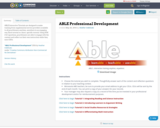
ABLE Interactive Tutorials are designed to make training from supplemental service providers available to all practitioners anytime, anywhere in an engaging way. Each tutorial is a short, specific tutorial. Using DOK 2 & 3 questions, practitioners are able to engage with the content and reflect on their own instruction while they earn CEUs.
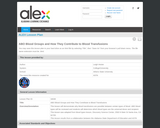
This lesson will demonstrate why blood transfusions are possible between certain types of blood. ABO blood types will be reviewed and students will determine which blood types are the universal donor and recipient. This lesson was adapted from blood types lesson, Discovery Science Center, 2500 N Main St Santa Ana, CA 92705. This lesson results from a collaboration between the Alabama State Department of Education and ASTA
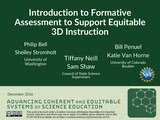
In this professional development session, we will develop a shared understanding of how formative assessment works and different approaches that have been developed. The material for this resource come from a series of PD sessions on formative assessment developed by the ACESSE team: Philip Bell, Shelley Stromholt, Bill Penuel, Katie Van Horne, Tiffany Neill, and Sam Shaw.We will be updating this Facilitator's Guide for ACESSE Resource A with the most up-to-date information about this resource over time. If you encounter problems with this resource, you can contact us at: STEMteachingtools@uw.edu

The NRC Framework for K-12 Science Education and the resulting Next Generation Science Standards focus on an integrated three-dimensional view of science learning in which students develop understanding of core ideas of science and crosscutting concepts in the context of engaging in science and engineering practices.How is assessing three-dimensional science learning different than how we have thought of science learning in the past? How can we design assessment tasks that elicit student’s current understanding of specific aspects of the disciplinary core ideas, science and engineering practices, and crosscutting concepts in order to shape future instruction? In this workshop, participants will learn how to interpret and design cognitive formative assessment to fit a three-dimensional view of learning.This resource originates from a series of PD sessions on 3D formative assessment developed and provided by Katie Van Horne, Shelley Stromholt, Bill Penuel, and Philip Bell. It has been improved through a collaboration in the ACESSE project with science education experts from 13 states. Please cite this resource as follows:Stromholt, S., Van Horne, K., Bell, P., Penuel, W. R., Neill, T. & Shaw, S. (2017). How to Assess Three-Dimensional Learning in Your Classroom: Building Assessment Tasks that Work. [OER Professional Development Session from the ACESSE Project] Retrieved from http://stemteachingtools.org/pd/SessionB
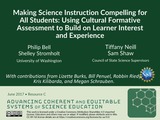
How can science instruction be meaningfullyconnected to the out-of-school lives of students? In this professional development, we will consider how to design formative assessments that build on learners’ interest and knowledge, promoting equity and social justice in the process. The material for this resource comes from a series of PD sessions on formative assessment originally developed by Philip Bell and Shelley Stromholt.We will be updating this Facilitator's Guide for ACESSE Resource C with the most up to date information about this resource over time. If you encounter problesm with this resources, you can contact us at STEMteachingtools@uw.eduThis resource was refined through a 13-state collaboration to make the resource more broadly useful. If you choose to adapt these materials, please attribute the source and that it was work funded by the National Science Foundation (NSF).
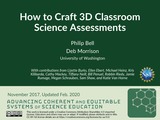
Abstract: This session provides a step-by-step process to support participants as they design a 3D assessment task for the science classroom. Along the way, they learn how to define 3D learning performances for specific lessons—and how to use a range of tools to support their assessment design work. A key goal of the session activity is to improve the connection of intended learning goals to assessment practices. Participants build their 3D assessment design capacity by designing and workshopping tasks—before piloting them in their classrooms. The approaches learned in this workshop can be used with any curricula, at any grade level, and across all subjects of science.
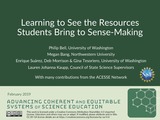
Overview: In this workshop, we will build our capacity to identify the range of intellectual resources students use as they make sense of phenomena. We will first explore how equity and justice relate to culture-based approaches to pedagogy—and then focus on how to identify and leverage the resources students use in moments of sensemaking. This resource can also be used by individuals wanting to learn how equity involves promoting the rightful presence of all students across scales of justice, desettling inequities, and supporting expansive learning pathways. This workshop provides participants with an opportunity to explore important theoretical ideas by exploring examples of how learners engage in diverse sense-making. Participants will learn about some of the challenges that less expansive learning environments can cause for learners from non-dominant communities. This resource is estimated to take between 161-268 minutes (2 ⅔ - 4 ¾ hours), depending on the choices of the facilitator in scenario selection.

This resource is a video abstract of a research paper created by Research Square on behalf of its authors. It provides a synopsis that's easy to understand, and can be used to introduce the topics it covers to students, researchers, and the general public. The video's transcript is also provided in full, with a portion provided below for preview:
"Traumatic brain injury (TBI), or brain damage caused by a sudden blow or jolt to the head, is a leading cause of death and disability worldwide. The mechanisms are complex and differ among patients, making TBI difficult to treat, and anti-inflammatory agents that are effective in animal models have been less promising in human trials, indicating that better treatments are needed. To explore new strategies, a recent study investigated the effect of the anti-inflammatory compound ACT001 on TBI. In mice, ACT001 reduced brain damage and improved motor function after TBI by reducing trauma-induced activation of microglia, which are immune cells of the central nervous system. In vitro, ACT001 also reduced activation of mouse and rat microglia induced by the bacterial toxin lipopolysaccharide (LPS) and downregulated LPS-induced secretion of proinflammatory molecules in a mouse microglial cell line..."
The rest of the transcript, along with a link to the research itself, is available on the resource itself.

This resource is a video abstract of a research paper created by Research Square on behalf of its authors. It provides a synopsis that's easy to understand, and can be used to introduce the topics it covers to students, researchers, and the general public. The video's transcript is also provided in full, with a portion provided below for preview:
"Myocardial infarction (MI), or heart attack, can cause long-term damage that leads to heart failure. To treat this type of heart failure, it’s critical to heal the pathological structural changes in the heart and preserve cardiac function. A recent study investigated potential treatment targets by exploring the role of the enzyme ADAM17, whose levels are increased during MI. In a group of 152 patients with MI, high ADAM17 levels were associated with a greater incidence of subsequent heart failure, as well as poorer heart function and higher mortality, suggesting a negative role of ADAM17. In mice with MI, elevated ADAM17 levels were linked to heart damage, but blocking ADAM17 activity limited the cardiac damage and remodeling after MI. Experiments in cultured heart cells revealed that ADAM17 exerted its harmful effects by promoting loss of the cardioprotective enzyme ACE2 and that the activation of ADAM17 depended on modification of a specific site in the protein p38 MAPK..."
The rest of the transcript, along with a link to the research itself, is available on the resource itself.
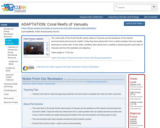
The coral reefs of the South Pacific island nation of Vanuatu are the backbone of the island's environmental and economic health. Today they face destruction from a silent predator that can rapidly decimate an entire reef. In this video, students learn about how a starfish is destroying the coral reefs of Vanuatu and how the islanders are adapting.
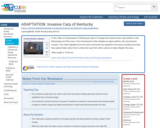
In this video, an entrepreneur is finding new ways to manage the invasive Asian carp problem in the Mississippi and Ohio rivers. Once introduced to help mitigate an algae problem, the carp became invasive. This video highlights how the local community has adapted to the issue, including how they have gained ideas about how to utilize the carp from other cultures to help mitigate the issue.

This exercise should be used after you think students know what AFM diagrams are and how they work. This is sort of a quiz -- to see if they can properly interpret the diagrams. There is no point moving on to real projects that involve AFM diagrams if the students don't understand the basics.
(Note: this resource was added to OER Commons as part of a batch upload of over 2,200 records. If you notice an issue with the quality of the metadata, please let us know by using the 'report' button and we will flag it for consideration.)

This training course is an introduction to the use of the AFNI software suites for the analysis of functional MRI (fMRI) data. It is not intended as an introduction to how fMRI works but is aimed at people who are already doing fMRI data analysis, or those who will be in the near future.
AFNI (Analysis of Functional NeuroImages) is a leading software suite of C, Python, and R programs and shell scripts, primarily developed for the analysis and display of anatomical and fMRI data. It is freely available for research purposes.
This event was organized by the Center for Brains, Minds, and Machines (CBMM) Trainee Leadership Council.
CBMM is a multi-institutional NSF Science and Technology Center headquartered at MIT that is dedicated to developing a computationally based understanding of human intelligence and establishing an engineering practice based on that understanding. CBMM brings together computer scientists, cognitive scientists, and neuroscientists to create a new field—the science and engineering of intelligence.

This resource is a video abstract of a research paper created by Research Square on behalf of its authors. It provides a synopsis that's easy to understand, and can be used to introduce the topics it covers to students, researchers, and the general public. The video's transcript is also provided in full, with a portion provided below for preview:
"Healthy corneas are clear and lack blood vessels, but injuries like alkali burns can trigger neovascularization. This serious complication reduces the patient’s vision and is the leading cause of failure in corneal transplants. Previous studies have suggested that AIP1 (Apoptosis signal-regulating kinase 1-interacting protein) is involved in inflammatory neovascularization induction and that NOX4 (NADPH oxidase 4) is activated by alkali burns. NOX4 can produce reactive oxygen species (ROS) which unbalance the expression of the inflammation-related proteins NLRP3 and NLRP6 (NLR family pyrin domain containing 3 and 6). Researchers recently used a mouse model to examine how AIP1 and NOX4 are related to NLRP3/NLRP6 after corneal alkali burns. Corneal alkali burns decreased AIP1 expression and increased the expression of two pro-angiogenic proteins, clv-IL-1β (cleaved interleukin-1β) and VEGFa (vascular endothelial growth factor A)..."
The rest of the transcript, along with a link to the research itself, is available on the resource itself.

This resource is a video abstract of a research paper created by Research Square on behalf of its authors. It provides a synopsis that's easy to understand, and can be used to introduce the topics it covers to students, researchers, and the general public. The video's transcript is also provided in full, with a portion provided below for preview:
"Some proteins are central to many cell signaling processes. One of these key molecules is AKT2. An important kinase involved in cell survival, growth, and metabolism, it has ties to insulin-induced signaling and cancer. AKT2 has a critical role in immune cells such as neutrophils and macrophages; however, although AKT2 is expressed in antibody-producing immune cells called B cells, its function in B cells isn’t clear. In a recent study, researchers sought to understand the role of AKT2 in B cells using AKT2-deficient mice. They found that mice lacking AKT2 had impaired B-cell differentiation. B cells from these mice were not able to form a cluster of molecules called a signalosome in response to B-cell receptor (BCR) signaling, resulting in poor BCR signaling and impaired B cell activation and spreading. These results suggest that as a central orchestrator of signaling, AKT2 function is critical for proper BCR signaling and B cell development, ensuring a functional antibody-mediated immune response..."
The rest of the transcript, along with a link to the research itself, is available on the resource itself.

This resource is a video abstract of a research paper created by Research Square on behalf of its authors. It provides a synopsis that's easy to understand, and can be used to introduce the topics it covers to students, researchers, and the general public. The video's transcript is also provided in full, with a portion provided below for preview:
"Gq protein-coupled receptors (GqPCRs) are membrane bound proteins that transmit signals from outside the cell to internal signaling pathways. One of these pathways is the PI3K/AKT pathway, which plays roles in cellular proliferation, survival, metabolism, and differentiation. PI3K/AKT dysregulation is also often implicated in cancers. A previous study determined that activating GqPCRs in certain cells inactivated AKT, which led to a specific type of cell death, JNK-dependent apoptosis. This unique signal seems to play an important role in physiological and pathological events like pituitary development and cardiac hypertrophy. Now, a new study determined that the mechanism of this AKT inactivation relies on another signaling-related protein, PP2A. When the GqPCRs are not activated, a fraction of PP2A "c" subunit is in a dimer complex with another protein, IGBP1 and they are bound to the p85 subunit of PI3K, causing its activation..."
The rest of the transcript, along with a link to the research itself, is available on the resource itself.
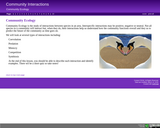
Introduction to community interactions for AP Biology.